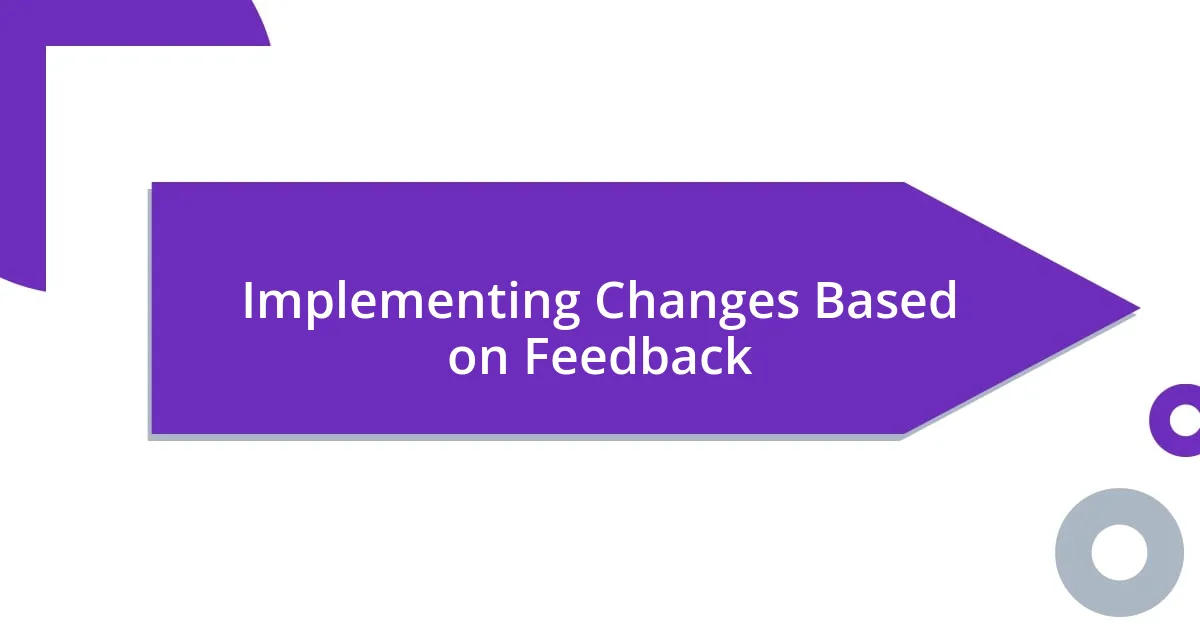Key takeaways:
- Client feedback is essential for improving service quality and fostering deeper relationships, focusing on warmth and approachability.
- Analyzing feedback reveals common themes and allows for targeted changes, enhancing overall client experience and satisfaction.
- Implementing feedback, such as regular updates and improved presentation formats, leads to increased client engagement and collaboration.
- Building long-term relationships relies on open communication, authenticity, and celebrating milestones to strengthen connections with clients.

Understanding Client Feedback Importance
Client feedback is like a compass guiding me through the complex landscape of my service offerings. One time, after a project, a client expressed that my communication style felt impersonal. I realized then how essential it is to convey warmth and approachability in my interactions, not just professionalism. It’s a reminder that clients aren’t just looking for a product; they want a connection.
Every piece of feedback is an opportunity for growth. I remember a particularly tough session where the feedback was overwhelmingly negative. Initially, it stung, but I took a step back, analyzed the comments, and turned that feedback into a game plan for improvement. Isn’t it fascinating how discomfort can lead to valuable insights that ultimately enhance our services?
Understanding client feedback enables me to refine my skills and build deeper relationships. When a client mentions they felt heard, it resonates with me profoundly. It’s reassuring to know that by integrating their suggestions, I not only improve my work but also strengthen trust. How could we not value that powerful connection when it has the potential to elevate our services to new heights?

Analyzing Client Feedback for Insights
Analyzing client feedback can sometimes feel like deciphering a puzzle. One memorable instance was when I received comments about my project timelines being unclear. This prompted me to dig deeper. I reached out to clients for further details, and their insights revealed a consistent theme: they needed clearer milestones and expectations. It was a lightbulb moment for me, illustrating how a little extra clarity could significantly enhance their experience.
When I review feedback, I look for common threads. Here are a few methods I find particularly helpful:
- Categorization: I group feedback into themes like communication, timeliness, and deliverables. This helps me pinpoint recurrent areas of concern.
- Root Cause Analysis: I dig beyond surface-level comments to understand why clients feel a certain way, helping me develop tangible solutions.
- Follow-Up Engagement: I often follow up with clients who provide critical feedback, asking them comprehensive questions. This not only shows I care but often uncovers even richer insights.
By engaging deeply with client input, I’ve discovered that their perspectives often illuminate pathways I hadn’t considered, enriching both my process and the overall client relationship.

Implementing Changes Based on Feedback
Implementing changes based on client feedback can feel both daunting and rewarding. I recall a client who shared their desire for more regular updates during a lengthy project. Taking that to heart, I began scheduling bi-weekly check-ins. Not only did this simple adjustment foster trust, but it also kept the client engaged throughout the process, enhancing their overall experience. Sometimes, even small changes can lead to significant improvements.
After making adjustments based on feedback, I noticed a remarkable shift in my client relationships. For instance, I once received multiple comments regarding the delivery format of my reports. After switching to a more visually appealing layout that featured infographics and key takeaways, I observed clients responding more positively. Their engagement on follow-up calls increased, and I felt a deeper connection during our conversations, allowing for better collaboration. It’s powerful to see how clients appreciate when their voices shape the final product.
When I implement feedback, I always look for the balance between my professional style and the client’s desires. A client suggested that I offer more examples in my presentations, which prompted me to develop a dedicated section for case studies. This not only enriched my presentations but also resonated with the clients, establishing a more relatable dialogue. It’s these tailored adjustments that make the feedback process truly invaluable—transforming critique into practice for a win-win outcome.
| Feedback Type | Action Taken |
|---|---|
| Regular Updates | Scheduled Bi-Weekly Check-Ins |
| Report Format | Switched to Infographic Layout |
| Presentation Content | Added Case Studies |

Measuring the Impact of Changes
Measuring the impact of changes is crucial to understanding the effectiveness of the adjustments I’ve made based on client feedback. I remember implementing a new project management tool after clients expressed frustration with our previous system. The transition was a bit nerve-wracking, but I vividly recall the moment when a client praised the newfound clarity it provided. Their relief transformed into excitement, making it clear that the change was meaningful.
To effectively measure this impact, I often rely on key performance indicators (KPIs) tied to client satisfaction. For example, after enhancing our communication strategy, I started to track response times and client engagement levels in follow-ups. When I noticed a significant increase in positive feedback during client calls, I couldn’t help but feel a rush of validation. Are the changes truly resonating? That data spoke volumes, giving me the confidence to continue adjusting my approach.
Additionally, I find it invaluable to engage in regular feedback loops. After rolling out specific changes, I invite clients to share their experiences. This practice not only helps me gauge the effectiveness of the adjustments but also fosters a sense of collaboration. I recall a moment after introducing a new reporting format when a client eagerly shared their thoughts. Their enthusiasm reminded me that measuring impact is an ongoing conversation, not just a one-time evaluation.

Building Long-Term Client Relationships
Building long-term client relationships is an art that thrives on open communication and genuine connection. I once had a client express their concern about feeling disconnected during a project. To address this, I invited them to participate in the planning meetings. Their engagement not only deepened their commitment but also transformed our interactions into collaborative brainstorming sessions. Isn’t it interesting how a simple invitation can foster a stronger bond?
Trust truly is the cornerstone of lasting partnerships. I learned this firsthand when a client and I faced a significant challenge together. By being transparent about the hurdles, instead of sugarcoating the situation, I noticed that they appreciated my honesty. This shared vulnerability created a stronger connection. It’s moments like these that underscore the importance of authenticity in every conversation. Can you recall a time when honesty changed the dynamics of your relationships?
Moreover, I’ve discovered that celebrating milestones together can significantly strengthen these bonds. I remember a project that reached a significant phase, and instead of just moving on, I organized a small virtual celebration. The client was thrilled; it was more than just business for them—it was about partnership. Taking that extra step to recognize achievements not only reinforces the connection but also reminds us that we’re in this journey together. How can you find ways to celebrate your clients’ successes? It’s a simple yet impactful practice that leaves a lasting impression.














